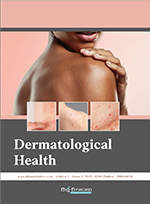Abstract
Cryptococcus neoformans can cause detrimental cryptococcosis and other severe complications, especially in immunocompromised populations. Disseminated cryptococcosis in organ transplantation patients is extremely rare and often involves lungs, brains, skin, nails, and other organs. In this paper, we report a rare disseminated cryptococcosis case involving skin and lung that presented with recurrent dark brown abscesses and nodules in an immunocompromised female after kidney transplantation. The K-Set detection result of Cryptococcus capsular polysaccharide in serum is positive. The identification of pus culture by Autof MS 1000 indicates that the patient was infected with Cryptococcus neoformans var. grubii. In addition to treatment using liposomal amphotericin B, fluorocytosine, and fluconazole, local extraction of pus and simultaneous injection of liposomal amphotericin B into skin lesions were performed. This comprehensive treatment method proved effective, as the patient recovered from fever and skin symptoms. The innovative treatment may contribute to helping more disseminated cryptococcosis patients.
References
Rai N, Kumari Keshri P, Verma A, et al., 2021, Plant Associated Fungal Endophytes as a Source of Natural Bioactive Compounds. Mycology, 12(3): 139–159.
Hong N, Chen M, Fang W, et al., 2017, Cryptococcosis in HIV-Negative Patients with Renal Dialysis: A Retrospective Analysis of Pooled Cases. Mycopathologia, 182(9–10): 887–896.
Ratemo SN, Denning DW, 2023, Burden of Fungal Infections in Kenya. Mycology, 14(2): 142–154.
Bahn YS, Sun S, Heitman J, et al., 2020, Microbe Profile: Cryptococcus neoformans Species Complex. Microbiology (Reading), 166(9): 797–799.
Fang W, Wu J, Cheng M, et al., 2023, Diagnosis of Invasive Fungal Infections: Challenges and Recent Developments. J Biomed Sci, 30(1): 42.
May RC, Stone NR, Wiesner DL, et al., 2016, Cryptococcus: From Environmental Saprophyte to Global Pathogen. Nat Rev Microbiol, 14(2): 106–117.
Takashima M, Sugita T, 2022, Taxonomy of Pathogenic Yeasts Candida, Cryptococcus, Malassezia, and Trichosporon. Med Mycol J, 63(4): 119–132.
Kwon-Chung KJ, Fraser JA, Doering TL, et al., 2014, Cryptococcus neoformans and Cryptococcus gattii, the Etiologic Agents of Cryptococcosis. Cold Spring Harb Perspect Med, 4(7): a019760.
Díaz-Ramírez GS, Martínez-Casas OY, Marín-Zuluaga JI, et al., 2020, Disseminated Cryptococcosis After Liver Transplant: A Case Report. Exp Clin Transplant, 18(3): 402–406.
Hayashida MZ, Seque CA, Pasin VP, et al., 2017, Disseminated Cryptococcosis with Skin Lesions: Report of a Case Series. An Bras Dermatol, 92(5 Suppl 1): 69–72.
Ruan Q, Zhu Y, Chen S, et al., 2017, Disseminated Cryptococcosis with Recurrent Multiple Abscesses in an Immunocompetent Patient: A Case Report and Literature Review. BMC Infect Dis, 17(1): 369.
Ghioldi ME, Dealbera ED, Chemes LN, et al., 2021, Cryptococcus neoformans Osteomyelitis of the Calcaneus: Case Report and Literature Review. SAGE Open Med Case Rep, 2021(9): 1–7.
Chen M, Zhou J, Li J, et al., 2016, Evaluation of Five Conventional and Molecular Approaches for Diagnosis of Cryptococcal Meningitis in Non-HIV-Infected Patients. Mycoses, 59(8): 494–502.
Du L, Yang Y, Gu J, et al., 2015, Systemic Review of Published Reports on Primary Cutaneous Cryptococcosis in Immunocompetent Patients. Mycopathologia, 180(1–2): 19–25.
Adzic-Vukicevic T, Cevik M, Poluga J, et al., 2020, An Exceptional Case Report of Disseminated Cryptococcosis in a Hitherto Immunocompetent Patient. Rev Inst Med Trop Sao Paulo, 2020(62): e3.
Chavapradit N, Angkasekwinai N, 2018, Disseminated Cryptococcosis in Crohn’s Disease: A Case Report. BMC Infect Dis, 18(1): 620.
Francisco EC, De Jong AW, Hagen F, 2021, Cryptococcosis and Cryptococcus. Mycopathologia, 186(5): 729–731.
Zatti MS, Arantes TD, Theodoro RC, 2020, Isothermal Nucleic Acid Amplification Techniques for Detection and Identification of Pathogenic Fungi: A Review. Mycoses, 63(10): 1006–1020.
Bodulev OL, Sakharov IY, 2020, Isothermal Nucleic Acid Amplification Techniques and Their Use in Bioanalysis. Biochemistry (Mosc), 85(2): 147–166.
